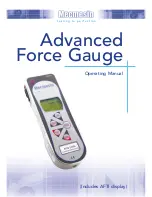
page 9
Press the
MAX
key again and the word MAX has now
disappeared from the display. The display will now
indicate forces applied in both directions as they are
applied to the loadcell and maintain a “running” display.
Press the RESET key to clear both maximum registers
and prepare for detecting the next maximum readings.
(See also COMMS section of Advanced Menu Options
on page 28)
An uncalibrated analogue output is available from the
top ‘D type connector marked ‘coms’ for use with chart
recorders, oscilloscopes or any other devices requiring
analogue inputs. A calibrated analogue output can also
be supplied as an option (calibrated to order at factory).
See technical specifications on page 54 and 55 for
details.
It is possible to transmit the displayed reading
to peripheral devices (e.g. PC, printer) via the
communications port by pressing and releasing the
TXD
key.
Displayed readings can also be requested individually
from a PC via the RS232 interface by sending a “?”
character.
See page 37.
For sending a continuous data stream to a PC, printer,
etc press and hold the
TXD
key for 2 seconds then
release. TX will now appear in the display to indicate
that data is being sent, (see figure 5). To stop sending
data, simply press and release the
TXD
key, at which
point TX will disappear from the display.
“Normal” mode
Data Output
Analogue output
RS232 and Digimatic
output signals
A full range of interface cables
are available to connect your
AFG to peripheral devices – see
page 56 for details.
Continuous data
transmission
The continuous data stream rate
is 25Hz, unless 115200 Baud is
selected, when it is 50Hz.
When using continuous
transmission over RS232 only,
select the TX METHOD as RS232
(see page 29). If DIGIMATIC
or DUAL is selected, and no
digimatic device is connected,
the display will periodically
freeze.
Fig. 5
Max compression
reading











































